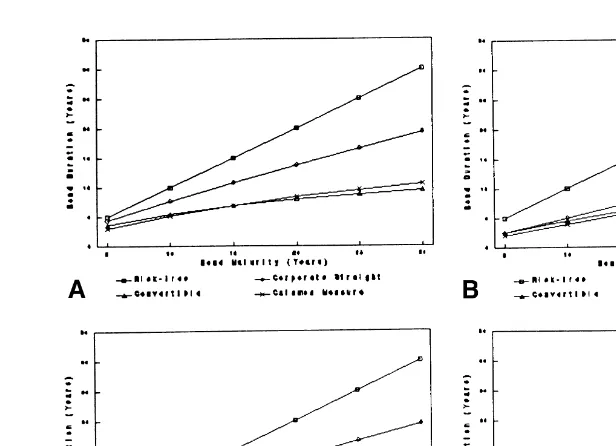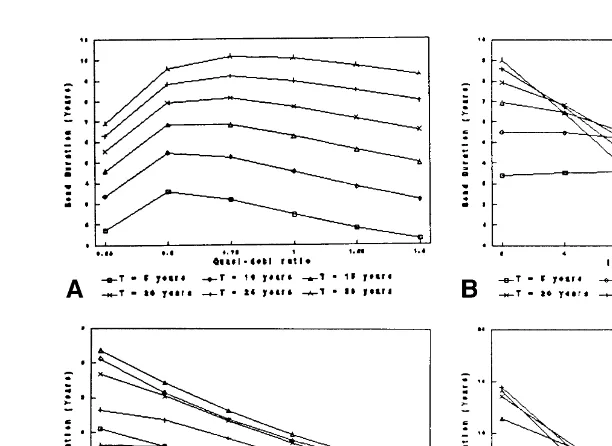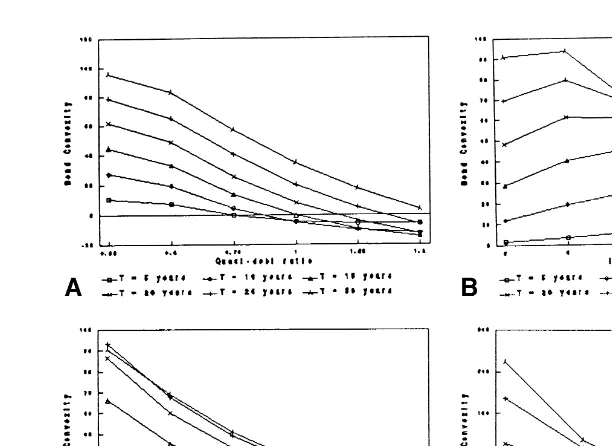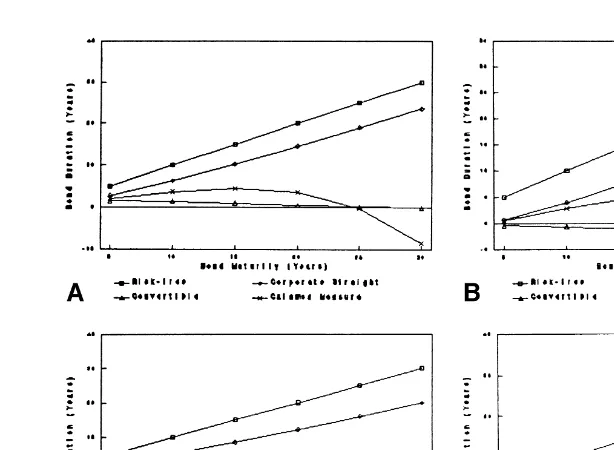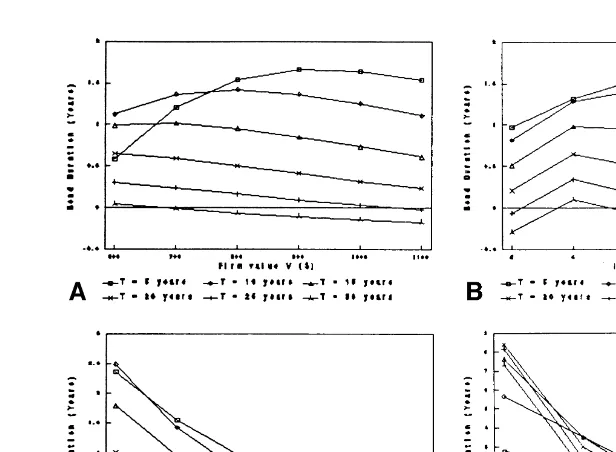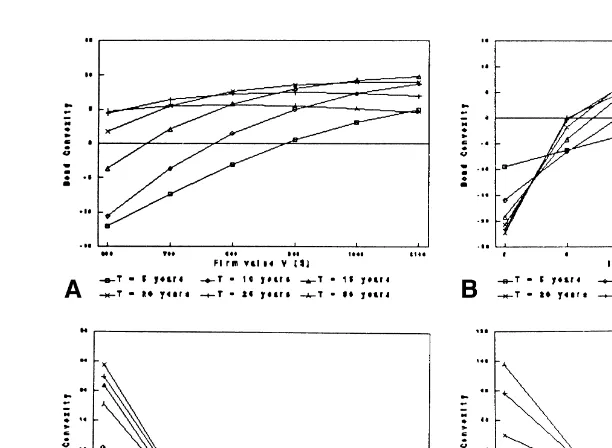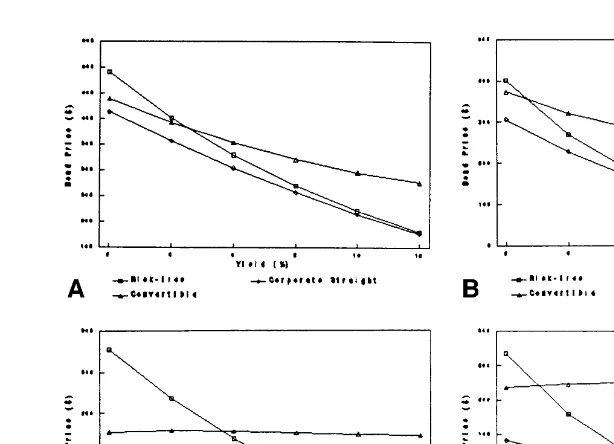Duration and Convexity of Zero-Coupon
Convertible Bonds
Sudipto Sarkar
Duration and convexity are important measures in fixed-income portfolio management. We have derived closed-form expressions for duration and convexity of zero-coupon convertibles, incorporating the impact of default risk, conversion option, and subordina-tion. The overall effect is to shorten duration, while the effect on convexity is ambiguous. Both measures were found to be very different from those of straight bonds, in magnitude and in their response to parameter changes; e.g., a subordinated convertible duration can even be negative. Thus, it would be inappropriate to use traditional duration/convexity measures for evaluating or hedging interest rate risk in convertibles. © 1999 Elsevier Science Inc.
Keywords: Convertible bond; Duration; Convexity
JEL classification: G32
I. Introduction
In view of increasingly volatile interest rates in recent years, quantifying and hedging interest rate risk have become essential activities for fixed-income investors, particularly insurance and pension fund managers. Interest rate risk is also of increasing importance to corporate treasurers because of recent increases in corporate cash pools well in excess of short-term cash requirements [see Toevs (1986a)]. Perhaps the two most important indicators of interest rate risk are duration and convexity. Duration provides a measure of the responsiveness of a bond’s (or portfolio’s) price to interest rate changes: the longer the duration, the greater the price sensitivity and the higher the interest rate risk. Convexity measures the rate of change of duration with respect to interest rates, and thus accounts for the second-order effects of interest rate changes which are not captured by duration. Not surprisingly, duration and convexity are, today, indispensable tools for fixed-income investors and bond portfolio managers and dealers [see Toevs (1986a); Chance (1990);
Department of Finance, College of Business Administration, University of Houston, Houston, Texas. Address correspondence to: Dr. S. Sarkar, Department of Finance, College of Business Administration, University of Houston, Houston, TX 77204-6282.
Kritzman (1992), among others]. The concept of duration is also widely used in gap management and asset-liability management in banks and other financial institutions.
Although most of the analytical work on duration and convexity has traditionally been limited to Treasury (default-free) bonds, some recent work [Chance (1990); Nawalkha (1995, 1996) among others] has examined option-free corporate bond duration under default risk. Empirical studies such as Ilmanen (1992) and Ilmanen et al. (1994) have found that duration provides a fairly accurate measure of risk for option-free corporate bonds. Many corporate bonds, however, contain some embedded options. The interest rate sensitivities of these options should not be ignored; hence, the duration and convexity measures for these bonds need to be option-adjusted. To quote Ilmanen et al. (1994, page 76), “ . . . we can expect that a properly option-adjusted duration measure will also serve as a good measure of relative risk.” The fact that embedded options are important in determining corporate bond durations has been empirically documented by Ogden (1987). Ogden found that embedded options such as the call feature and the sinking fund provision had a significant impact on the interest rate sensitivity of corporate bonds. Hence, the need to explicitly take into account these options when estimating bond duration and convexity. The two most common option-containing corporate bonds are callable and convertible bonds. Callable bonds have been examined by Dunetz and Mahoney (1988), Douglas (1990), Toevs (1986b), Riley and Sidhu (1987), and Nawalkha (1995), among others.
This paper focuses on convertible bonds. The convertible market is certainly large enough [Billingsley et al. (1988)] to warrant a thorough examination of its interest rate risk characteristics. For hedging interest rate risk in convertibles, we must have adequate measures of their duration and convexity. Moreover, convertible bond duration and convexity estimates are required for the popular investment strategy convertible bond arbitrage [see Ferguson et al. (1995) for details].
Surprisingly, very little work has been done on convertible bond duration or convexity (see Section I.A). On one hand, there are studies which have attempted to estimate convertible duration/convexity with ad-hoc measures, without the benefit of a full-blown valuation model. On the other hand, there are well-known valuation models based on the contingent-claims approach [Ingersoll (1977); Brennan and Schwartz (1980), among others], which have great potential but have not been applied to the issue of interest rate sensitivity. Thus, there is a gap in the literature which our paper attempts to address by utilizing a contingent-claim valuation model to derive estimates for duration and convex-ity of a zero-coupon convertible bond, with explicit consideration of both default risk and the conversion option.
An exception to the above argument is a financial institution (commercial bank or savings and loan) the assets of which (mostly long-term fixed-rate loans) are significantly more sensitive to interest rates than its liabilities (mostly short-term deposits). The equity of such a firm will be more sensitive to interest rates than a corporate bond issued by it. Thus, for a firm with assets which are highly sensitive to interest rates, it is possible for equity duration to exceed bond duration, which implies that its convertible bond duration will exceed straight bond duration.1 However, such a scenario is ruled out in our model because we assume that the firm’s asset value is insensitive to interest rates (our equation (1)). The first step in any duration computation is to derive the value of the bond. To that end, we will use the standard contingent-claim model of Chance (1990) or Brennan and Schwartz (1980) to value a zero-coupon convertible corporate bond, from which we derive its duration and convexity. We will begin the analysis (Section II) with the duration and convexity of a zero-coupon convertible bond, a comparison with a straight (non-convertible) bond, and the response to parameter value changes. In Section III, we will examine the effect of subordination on duration and convexity, and empirically estimate the duration of two zero-coupon corporate convertible bonds. Section IV summarizes the main results of the paper.
A. Existing Papers
Mehran and Homaifar (1993) derived the convertible bond duration in terms of the sensitivity of the call option value to changes in the convertible value (theirl). By itself, their formula is useless because the l cannot be computed without a valuation model. They [Mehran and Homaifar (1993, p. 111)] also concluded (incorrectly2) that “whenl is positive, the option is in the money and the duration of a convertible bond is greater than the duration of a pure bond.” Finally, their model ignores the fact that all the inputs in their formula (i.e., straight bond price, convertible price, and sensitivityl) are inter-related, as they all depend on the (stochastic) firm value. If these values are specified exogenously, as done in their numerical illustration, there is no guarantee of internal consistency; hence,
1I am grateful to an anonymous referee for pointing out this possibility.
2It can easily be shown that the duration of a convertible bond is actually shorter than the duration of a
non-convertible bond, as follows. The convertible bond can be viewed as a straight bond plus a number of warrants (say #); then:
PCB5PSB1#W.
If we differentiate this with respect to r and divide by2PCB, the duration of the convertible is:
DCB5~PSB/PCB!DSB2#~1/PCB!~W/r!,
which simplifies to:
DCB5DSB2#W~DSB/PCB!2#~1/PCB!~W/r!.
BecauseW/r is positive from basic option theory, it is clear that DCB,DSB. In equation (9) of Mehran and Homaifar (1993), the convertible duration is given by:
DCB5DSBz~PSB/PCB!z1/~12l!.
the results might be meaningless. It is clear that any duration/convexity study should be anchored in a valuation model.
Brooks and Attinger (1992) took a similar approach, and expressed convertible bond duration in terms of straight bond duration, equity duration, rho of the conversion option, and sensitivity of equity return to the yield. Although their derivation is definitionally correct, it does not explain how the conversion option is valued, nor does it provide values for rho and delta, as there was no valuation model. As to the magnitude of convertible duration, they [Brooks and Attinger (1992, p. 77)] stated “ . . . intuitively, we anticipate the duration of the callable convertible bond to exceed that of a callable bond with the same yield in most cases.”
Finally, there are a number of practitioner-oriented studies, e.g., Calamos (1988), Gepts (1987), and Ferguson et al. (1995), which provided approximations, but did not explicitly derive the duration or convexity of convertible bonds. These, however, agreed with the general notion that convertible bond duration should be shorter than the duration of the underlying straight bond. Calamos (1988) provided a closed-form but approximate for-mula for convertible bond duration,3which could serve as a practical benchmark for our results. The Ferguson et al. (1995) procedure consisted of using binomial trees to approximate the convertible value, and to repeat the valuation with a small change in the interest rate, and compare the two values to gauge the duration.
It is clear that a comprehensive duration and convexity model needs to be developed for convertible bonds. This paper is hopefully a step in that direction; we will provide closed-form expressions for the duration and convexity of a zero-coupon convertible bond (both senior and subordinated). Our model follows the contingent-claim approach of Ingersoll (1977) and Brennan and Schwartz (1980), which is appropriate because it explicitly takes into account the conversion option.
II. Duration and Convexity of a Senior Convertible Bond
A. Senior Convertible Bond ValuationWe assume that the firm value, V, (i.e., value of its assets) follows the well-established stochastic log-normal process of Chance (1990), Brennan and Schwartz (1980) and Ingersoll (1977), among others:
dV
V 5mdt1sdz, (1)
wherem5expected growth rate;s5volatility of the firm; and z5standard Brownian Motion Process. Thus, the state variable in our model is firm value, V, as in virtually all contingent-claims models. This reality was recognized by Ferguson et al. (1995, p. 110), who stated that “ . . . in reality, all the firm’s securities are derivatives of the firm’s total value. Thus, many of the (duration) models in the literature are incorrect.”
There is a non-callable zero-coupon convertible bond with face value, F, maturing in T years. The conversion feature gives the bondholders the option to convert their bonds to equity at maturity; upon conversion, they will own a fraction, x, of the equity of the firm. The
3Calamos (1988) suggested the following approximation: D
conversion fraction, x, essentially describes the conversion terms.4There is no other debt in the firm’s capital structure; hence, the convertible bond is senior or non-subordinated. Thus, there are only two claims on the firm’s net assets, equity and the convertible debt. The risk-free interest rate, r, is constant,5and there are no taxes or other frictions.
A couple of the above assumptions merit further discussion. First, because we assume zero coupons (in order to derive closed-form expressions) and because the majority of convertible bonds are coupon-bearing, it would be pertinent to ask whether the results would be drastically different if coupons were included. The presence of a coupon could potentially have a significant effect on the duration of a convertible bond; hence, the results of this paper might not be applicable to coupon-bearing convertibles. But as there are plenty of zero-coupon convertible bonds in the market,6and given that zero-coupon Treasuries have extremely large durations, the duration of a zero-coupon convertible bond is of interest in its own right (I thank an anonymous referee for pointing this out). Second, our model assumes that the convertible bond is non-callable (again, to get closed-form solutions), although most convertible bonds in real life are callable. However, we are of the opinion that the results of our model should be applicable to callable convertible bonds as well, for the following reason: the literature on corporate call policies has found that most convertibles are called late, the main reason for which is the cash flow advantage of delaying calls [Asquith (1995) and Asquith and Mullins (1991)]. Firms have an incentive to delay the call if the after-corporate-tax coupon payment to convertible holders is smaller than the dividend payable after conversion. Because the convertible in our model pays no coupons, the incentive to delay call will be particularly strong, and firms will tend to postpone calls as far as possible, thus making the callable bond very similar to a non-callable bond. Therefore, callable zero-coupon convertible bonds should behave like non-callable zero-coupon convertibles, and our results should be generally valid for callable bonds as well.
With the above model specifications and assumptions, it can be shown (the derivation is available from the author on request) that the convertible bond value will be given by:
PCB5VN~d1!1xVN~d2!1Fe 2rT@N~d
4!2N~d3!#, (2)
where N[is the cumulative distribution function for the standard normal distribution and
d15
4The conversion terms are commonly specified by a conversion ratio or a conversion price. Both of these
can be expressed in terms of the conversion fraction, x, as follows: suppose N5number of shares already in existence; let n5number of additional shares on conversion. Then x5n/(N1n) by definition, giving n5
xN/(12x). This is the number of shares bond holders get on conversion. As F5total face value of the entire convertible issue, the conversion price is F/n5(12x)F/(xN), and the conversion ratio is 10003N/((12x)F), if the face value of one convertible bond is $1,000.
5This assumption may be criticized because we are trying to determine the bond’s sensitivity to interest rate
changes [see Chance (1990, p. 267]. However, Brennan and Schwartz (1980, pp. 925–926) compared convertible prices under constant and stochastic interest rates and concluded that “for a reasonable range of interest rates the errors from the certain interest rate model are likely to be slight and, therefore, for practical purposes it may be preferable to use this simpler model for valuing convertible bonds”. Interest rate risk can nevertheless be incorporated in our model, as discussed in footnote 7.
6According to McGuire (1991, p. 36), “ . . . zero-coupon convertibles are in common use in the U.S.
d25
The duration of a bond is defined as follows:
D521
P P
r, (7)
where P5bond price, and r5interest rate. Differentiating equation (2) with respect to r, and using the above definition, we get the duration of the convertible bond (DCB) after
some simplification:
By using x 5 0 in the above equation, we get the duration of a straight or non-convertible bond; this gives us the same result as Chance (1990) (his equation (3a)), after incorporating the modification he made for interest rate risk.7It can easily be shown that the duration of a convertible bond is always shorter than that of an otherwise identical non-convertible bond.
Also, there is a risk-neutral interpretation of convertible duration [see Chance (1990)]. For a convertible bond, the three possible outcomes are:
Default: EPV5 VN(d1), and duration 50;
No default, no conversion: EPV5 Fe2rT[N(d4)2 N(d3)], and duration5 T; Conversion: EPV5 xVN(d2), and duration5 0.
We can see from equation (8) that the convertible duration is just the EPV-weighted duration of all the possible outcomes.
7Chance (1990) incorporated stochastic interest rates by assuming that the price of a risk-free bond, P(i, T),
follows a log-normal stochastic diffusion process as in Merton (1974), with the following parameters: variance sP
2(t), which can change deterministically through time, andr5correlation between firm value and P(i, T),
where i5default-free T-year interest rate. Although there might be disagreement over the exact form of the stochastic process (e.g., log normal might not be appropriate because of mean reversion and/or finite maturity), this has the useful property of incorporating interest rate risk.
In our model, incorporating interest rate risk in a similar manner would result in two changes: 1) rT in equation (2) would be replaced by2ln P(i, T), and 2) volatilitys2T would be replaced by:
E
0T@s21s
P
2~t!22rss
P~t!#dt.
Other than these two amendments, the procedure would be exactly the same.
Comparison of DCB with other duration measures. Figures 1a–1d show the above convertible duration, DCB, for four different sets of parameter values. For comparison, we
have also shown the duration of the following: 1) a default-free zero-coupon bond with the same maturity; 2) a corporate bond with exactly the same details (face value, maturity, etc.), except that it is non-convertible; and 3) a convertible bond using the Calamos (1988) approximation formula (see footnote 3). The parameter values used for these illustrations are specified in the figures.
First, we noticed that the duration of a non-convertible corporate bond was signifi-cantly shorter than that of a similar default-free bond; that is, default risk shortens the duration of a bond. This result is consistent with the empirical regularity reported by Ogden (1987). We also found that, as discussed above, the convertible bond duration was shorter than non-convertible bond duration, and the difference was larger for higher conversion fraction, x, and lower quasi-debt ratio.8 As for the approximate formula suggested by Calamos (1988), it turned out to be quite close to the exact duration (given by equation (8)) for most parameter value configurations. For senior convertible bonds, therefore, the Calamos formula provides a fairly good approximation for practical pur-poses. Finally, we observed that the duration drift (caused by the passage of time) was
8The quasi-debt ratio is defined as the ratio of the discounted face value of debt to the firm value, i.e.,
Fe2rT/V [see Merton (1973)].
Figure 1a. Comparison of various duration measures for a non-subordinated convertible bond. Parameters: F5 $600, r 5 6%, s5 0.25, Quasi-debt ratio 5 0.5, and x5 0.3. Figure 1b. Comparison of various duration measures for a non-subordinated convertible bond. Parameters:
F 5$600, r56%, s50.25, Quasi-debt ratio 51.0, and x50.3. Figure 1c. Comparison of various duration measures for a non-subordinated convertible bond. Parameters: F5$600, r5
smaller for convertible bonds than for non-convertible bonds. The duration drift is of interest to bond portfolio managers who periodically rebalance their portfolios to meet their duration objectives.
Comparative static results. To examine how the convertible duration changes with the underlying variables, we next performed some comparative static analyses. Because the derivatives could not be unambiguously signed, we present below some numerical illustrations of the behavior of convertible bond duration (Figures 2a–2d). These results were computed with the base-case parameter values specified in the figures.
(a) Quasi-debt ratio: As quasi-debt ratio was increased from 0.25 to 1.5, we found that the convertible bond duration first rose and then fell (Figure 2a). This is in contrast to straight bonds where duration falls monotonically [see Chance (1990)]. The explanation for the different behavior lies in the hybrid nature of convertible bonds. For very low quasi-debt values (i.e., high values of V), conversion is almost certain; hence, the convertible behaves like equity. As a result, the duration is short when the quasi-debt ratio is low. As the quasi-debt ratio rises (i.e., V falls), the convertible starts behaving more like a straight bond; hence, its duration becomes longer. However, as it now more strongly resembles a straight bond, any further increases in quasi-debt ratio will reduce the duration (as in the case of straight bonds). Hence, the convertible bond duration first rises and then falls. Incidentally, we can note that both interest rate risk and default risk are at about their lowest when the quasi-debt ratio is low.
Figure 2a. The relationship between duration and quasi-debt ratio for a non-subordinated convert-ible bond. Parameters: F5$600, r56%,s50.25, and x50.3. Figure 2b. The relationship between duration and interest rate for a non-subordinated convertible bond. Parameters: V5$800,
F5$600,s50.25, and x50.3 Figure 2c. The relationship between duration and firm risk,s
(Sigma), for a non-subordinated convertible bond. Parameters: V5$800, F5$600, r56%, and
x 5 0.3. Figure 2d. The relationship between duration and conversion fraction, x, for a
(b) Interest rate: We see from Figure 2b that convertible duration is generally a decreasing function of the interest rate (except for the case of short maturity bonds, T 5 5 years); this is just the opposite of how straight bond duration behaves [Chance (1990)]. Again, the difference arises from the hybrid nature of convertible bonds. For a straight bond, a higher interest rate reduces bond value without affecting firm value. This makes it resemble more strongly a risk-free bond; hence, the duration is longer. For a convertible bond, on the other hand, a higher interest rate means that the straight bond component has shrunk while the equity compo-nent remains unchanged. Hence, the convertible behaves more like equity, and duration falls. This explains why convertible duration is a decreasing function of the interest rate. Note, however, that for short-maturity bonds, the conversion option is not very significant. Therefore, the straight bond effect dominates the conversion effect for low interest rates, as a result of which the duration first rises and then falls.
(c) Firm risks: Convertible duration is a decreasing function of firm risk (Figure 2c), as in straight bonds [Chance (1990)]. A higher level of firm risk increases the probability of both default and conversion; both these effects cause duration to get shorter.
(d) Conversion fraction: The convertible bond duration is a decreasing function of the conversion fraction, x (Figure 2d). This is not surprising, because a higher x makes the convertible bond resemble equity more closely; hence, the duration is shorter.
C. Senior Convertible Bond Convexity
The convexity of a bond is defined as (2P/r2)/ 2P. Differentiating equation (2) twice with respect to r, and simplifying, we get:
2P
Using the above definition, we get the convexity of the convertible bond (CCB):
CCB5
where n[is the probability density function for the standard normal distribution. By setting x5 0, we can compute the convexity of a straight bond. The convexity of a convertible bond can be smaller than, equal to, or larger than the convexity of an otherwise identical straight bond (i.e., exactly the same face value and time to maturity, but no conversion feature). This is in contrast to the behavior of duration (see Section II.B). Also, the convexity could be negative, particularly for highly-leveraged firms (i.e., with high quasi-debt ratios).
(a) The convexity of a senior convertible bond is a decreasing function of quasi-debt ratio (Figure 3a).
(b) In general, convexity first increases and then decreases as interest rate is raised (Figure 3b). For short maturity bonds (T55 years), however, the convexity is an increasing function.
(c) Convexity is a decreasing function of firm risk (Figure 3c).
(d) Convexity is generally a decreasing function of conversion fraction (Figure 3d).
III. Duration and Convexity of Subordinated Convertible Debt
A. Valuation of a Subordinated Convertible BondHere, we extended the model of Section II to include senior non-convertible debt in the firm’s capital structure, so that the convertible became a subordinated bond. We assumed the senior non-convertible zero-coupon debt has face value, F1, and matures at time t5 T. The zero-coupon convertible bond has face value, F2, and also matures at t5T. The convertible holders have the option to convert the bonds to equity at maturity; on conversion, they will own a fraction, x, of the equity of the firm.
The value of this subordinated convertible bond can be shown to be (proof available from the author on request):
Figure 3a. The relationship between convexity and quasi-debt ratio for a non-subordinated con-vertible bond. Parameters: F5$600, r56%,s50.25, and x50.3. Figure 3b. The relationship between convexity and interest rate for a non-subordinated convertible bond. Parameters: V5
$800, F5$600,s50.25, and x50.3. Figure 3c. The relationship between convexity and firm risk,s(Sigma), for a non-subordinated convertible bond. Parameters: V5$800, F5$600, r5
6%, and x50.3. Figure 3d. The relationship between convexity and conversion fraction, x, for a
PSCB5V@N~d2!2N~d1!#2F1e
where N[again denotes the area under the normal distribution, and
d15
B. Duration of a Subordinated Convertible Bond
Differentiating equation (11) and using the definition of duration, we get the duration of a subordinated convertible bond (DSCB):
DSCB5Te2rT
F2@N~d5!2N~d4!#2F1@N~d4!2N~d3!#2xF1@12N~d5!# PSCB
.
(18)
It can be shown that this duration (DSCB) is always less than the duration of an
otherwise identical non-subordinated convertible bond (DCB). In fact, the duration of a
subordinate convertible can even be negative, as shown in our numerical examples below. A similar result was reported by Leland and Toft (1996) for non-convertible junk bonds. This result is caused by the presence of senior straight debt in the firm’s capital structure. A higher interest rate reduces the value of senior debt, and a large enough reduction can lead to a higher value of subordinated debt, resulting in negative duration.9
9Note that in our model, firm value, V, does not change with interest rates (i.e., V has zero duration) by
definition (equation (1)). Therefore, when senior debt value falls, equity value will rise. If default risk is sufficiently high, then junior or subordinate debt will take on the attributes of equity; hence, for high default risk, junior debt value will also rise when interest rates rise.
Comparison of DSCBwith other duration measures. Figures 4a–4d show the
subordi-nated convertible bond duration, DSCB, for four different sets of parameter values, along
with three other duration measures: 1) duration of a default-free zero-coupon bond with the same maturity; 2) duration of a corporate bond with exactly the same characteristics, except that it is non-convertible; and 3) convertible duration using the Calamos (1988) approximation formula (see footnote 2). The parameter values used for these illustrations are specified in the figures.
As in the case of senior debt, convertible bond duration was shorter than non-convertible bond duration. In all cases, the duration from our model was quite short and in some cases, even negative (as discussed above). However, the Calamos (1988) measure was significantly different from DSCB in this case. Unlike senior debt, the Calamos
formula is not a good approximation for subordinated convertible bonds.
Comparative statics. The comparative static results are shown in Figures 5a through 5d. These results are similar to the case of senior debt (Section II.B).
(a) Firm value V: As V increases, the convertible duration falls for the longer maturity bonds (T520, 25 and 30 years), and first rises and then falls for the other bonds (Figure 5a). When firm value rises, there are two effects: default risk falls, and so the bond bears a closer resemblance to a risk-free bond (this lengthens duration); also, conversion becomes more likely and, hence, the bond bears a closer resem-blance to equity (this shortens duration). For low values of V, the former effect
Figure 4a. Comparison of various duration measures for a subordinated convertible bond. Param-eters: V5$800, F15$300, F25$400, r56%,s50.25, and x50.3. Figure 4b.Comparison
of various duration measures for a subordinated convertible bond. Parameters: V 5$800, F15
$500, F2 5$400, r56%, s50.25, and x50.3. Figure 4c. Comparison of various duration
measures for a subordinated convertible bond. Parameters: V5$800, F15$300, F25$400, r5
dominates, therefore duration increases; for high values of V, the latter effect dominates; hence, duration falls. This explains the overall behavior for shorter-maturity bonds. For longer-shorter-maturity bonds, however, there is very little default risk, as the discounted face value is so small; therefore a higher V would imply that the conversion option effect is predominant; hence, the duration falls with V. (b) Interest rate: We see from Figure 5b that, as the interest rate was raised from 2%
to 12%, the duration of a subordinated convertible bond first rose and then fell. There are two effects when interest rate is raised: the value of the senior straight debt falls, so the default risk of the junior convertible will be lower (raising duration), and the value of the straight bond component of the convertible will fall, making it closer to equity (lowering duration). For lower interest rates, the former effect dominates; hence, the duration is upward sloping. For higher interest rates, the latter effect dominates; hence, the duration is downward sloping.
(c) Firm risk: As in the case of senior debt, the junior convertible duration is also a decreasing function of firm risk (Figure 5c). A higher level of firm risk increases the probability of both default and conversion; both these effects cause duration to get shorter.
(d) Conversion fraction: Also, as in the case of senior debt, the duration of a junior convertible bond is a decreasing function of the conversion fraction, x (Figure 5d). A higher x makes the convertible bond resemble equity more closely; hence, the duration is shorter.
Figure 5a. The relationship between duration and firm value, V, for a subordinated convertible bond. Parameters: F1 5 $300, F2 5$400, r 5 6%, s5 0.25, and x 5 0.3. Figure 5b. The
relationship between duration and interest rate for a subordinated convertible bond. Parameters:
V5$800, F15$300, F25$400,s50.25, and x50.3. Figure 5c. The relationship between
duration and firm risk,s, for a subordinated convertible bond. Parameters: V5$800, F15$300,
F2 5 $400, r 5 6%, and x5 0.3. Figure 5d. The relationship between duration and x for a
subordinated convertible bond. Parameters: V5$800, F15$300, F25$400, r56%, ands5
C. Convexity of a Subordinated Convertible Bond
Differentiating equation (11) twice with respect to r, we get:
2P
SCB
r2 5Te2rT
Î
Ts @xF1n~d5!1F2@n~d5!2n~d4!#2F1@n~d4!2n~d3!#
2T2e2rT@F
1@N~d4!2N~d3!#2F2@N~d5!2N~d4!#1xF1@12N~d5!#. (19)
Convexity is then given by:
CSCB5
2P
SCB
r2
2PSCB
, (20)
where the numerator and denominator are specified in equations (19) and (11), respec-tively. As in senior convertible debt, the convexity of a subordinated convertible bond may be smaller than, equal to, or larger than that of an otherwise identical non-convertible bond. It can also be negative, particularly for high leverage, short maturity, low interest rate, high conversion fraction and high firm risk.
Comparative static results. The comparative static results, illustrated in Figures 6a–6d, are very similar to those for non-subordinated convertible debt (Section II.C).
Figure 6a. The relationship between convexity and firm value, V, for a subordinated convertible bond. Parameters: F1 5 $300, F2 5$400, r 5 6%, s5 0.25, and x 5 0.3. Figure 6b. The
relationship between convexity and interest rate for a subordinated convertible bond. Parameters:
V5$800, F15$300, F25$400,s50.25, and x50.3. Figure 6c. The relationship between
convexity and firm risk,s, for a subordinated convertible bond. Parameters: V5$800, F15$300,
F25 $400, r 56%, and x 50.3. Figure 6d. The relationship between convexity and x for a
subordinated convertible bond. Parameters: V5$800, F15$300, F25$400, r56%, ands5
(a) The convexity is generally an increasing function of firm value, V, or a decreasing function of leverage (Figure 6a).
(b) In general, convexity first increases and then decreases as interest rate is raised, except for the short maturity bond (T55 years), where it is an increasing function (Figure 6b).
(c) Convexity is a decreasing function of firm risk, except for the short-maturity bond (Figure 6c).
(d) Convexity is a decreasing function of the conversion fraction, x, except for the short-maturity bond (Figure 6d).
D. Preliminary Empirical Investigation10
In order to gauge how well the model’s prediction fits actual convertible price behavior, two outstanding zero-coupon convertible bonds were investigated. These were issued by Boston Chicken and Motorola Corporation, and set to mature in January 2015 and September 2013, respectively. The duration for each convertible was estimated empiri-cally using the Ogden (1987) method. That is, convertible returns were regressed on changes in yields of a Treasury strip maturing at the same time. The coefficient of this regression provides an estimate of the convertible duration [see Ogden (1987) for details]. The estimated durations were 8.68 years for the Boston Chicken convertible, and 2.73 years for the Motorola convertible. The times to maturity (and, hence, the duration of the corresponding strip) were 19 and 17 years respectively. Thus, the zero-coupon convertible duration is significantly shorter than an otherwise similar zero-coupon risk-free bond, consistent with our model. Further, the Motorola convertible is subordinated whereas the Boston Chicken convertible is not (see Moody’s Industrial Manual and Moody’s OTC Unlisted Manual), as a result of which the former has a significantly shorter duration (relative to time to maturity); this is also consistent with our model. In conclusion, although this empirical section is preliminary in nature, it seems to be strongly supportive of our model’s major predictions.
IV. Conclusion
In this article, we have derived, for the first time, closed-form expressions for the duration and convexity of a zero-coupon corporate convertible bond. We have explicitly taken into account the default risk and the conversion option inherent in such securities, and also examined the impact of subordination of the convertible debt. Because the paper is built on a valuation model, the dependence of bond value, duration and convexity on the stochastic firm value has not been ignored as in previous studies.
We conclude that the duration of a zero-coupon convertible bond is shorter than the duration of an otherwise identical non-convertible bond; that is, the effect of the conver-sion option is to shorten duration. In the case of junior convertible debt, duration is even shorter and can be negative, implying that a rise in interest rate would increase bond value. The convexity of a convertible was also generally different from that of a straight bond. In some cases, the convexity was negative, implying a concave price-yield relationship.
10I would like to acknowledge the generosity of an anonymous referee in providing the data and the analysis
Figures 7a–7d illustrate how a zero-coupon convertible bond price behaves with respect to interest rate, and how it differs from non-convertible bonds (both corporate (risky) and risk-free). We can see that the convertible bond value is less sensitive to interest rate changes (i.e., shorter duration). For subordinated bonds, the convertible price might actually rise with interest rates (i.e., negative duration).
To conclude, the behavior of duration and convexity of corporate zero-coupon con-vertible bonds is very different from that of risk-free bonds or even non-concon-vertible corporate (risky) bonds. Hence, it would be highly inappropriate to use the traditional duration measures when evaluating or hedging interest rate risk in convertible bonds.
I would like to thank two anonymous referees for their suggestions which led to improvements in the paper, and also the editors, John Affleck-Graves and Kenneth Kopecky, for their advice. All remaining errors are the author’s responsibility.
References
Asquith, P. Sept. 1995. Convertible bonds are not called late. Journal of Finance 50(4):1275–1289. Asquith, P., and Mullins, D. W. Sept. 1991. Convertible debt: Corporate call policy and voluntary
conversion. Journal of Finance 46(4):1273–1289.
Figure 7a. Senior bond price as a function of interest rate. Parameters: V5$800, F5$600,s
50.25, x50.3, and T510 years. Figure 7b. Senior bond price as a function of interest rate. Parameters: V5$800, F5$600,s50.25, x50.3, and T520 years.Figure 7c. Subordinated bond price as a function of interest rate. Parameters: V5$800, F15$400, F25$400,s50.25,
Bhattacharya, M., and Zhu, Y. 1997. Valuation and analysis of convertible securities. In The Handbook of Fixed Income Securities (F. J. Fabozzi, ed.). Chicago: Irwin, pp. 791–817. Bierwag, G. O., Kaufman, G. C., and Toevs, A. July/Aug. 1983. Duration: Its development and use
in bond portfolio management. Financial Analysts Journal 39(4):15–35.
Billingsley, R. S., Lamy, R. E., and Thompson, G. R. Spring 1988. The choice among debt, equity, and convertible bonds. Journal of Financial Research 11(1):43–55.
Black, F., and Scholes, M. May-June 1973. The pricing of options and corporate liabilities. Journal of Political Economy 81(3):637–659.
Brennan, M., and Schwartz, E. Nov. 1980. Analyzing convertible bonds. Journal of Financial and Quantitative Analysis 15(4):907–929.
Brooks, R., and Attinger, B. July/Aug. 1992. Using duration and convexity in the analysis of callable convertible bonds. Financial Analysts Journal 48(4):74–77.
Calamos, J. P. 1988. Investing in Convertible Securities. New York, NY: U.S.: Longman Financial Services Publishing.
Chance, D. M. March 1990. Default risk and the duration of zero-coupon bonds. Journal of Finance 45(1):265–274.
Douglas, L. G. 1990. Bond Risk Analysis: A Guide to Duration and Convexity. New York: New York Institute of Finance.
Dunetz, M. L., and Mahoney, J. M. May/June 1988. Using duration and convexity in the analysis of callable bonds. Financial Analysts Journal 44(3):53–72.
Ferguson, R., Butman, R. E., Erickson, H. L., and Rossiello, S. Fall 1995. An intuitive procedure to approximate convertible bond hedge ratios and durations. Journal of Portfolio Management 22(1):103–111.
Gepts, S. J. 1987. Valuation and Selection of Convertible Bonds. New York: Praeger Publishing. Ilmanen, A. March 1992. How well does duration measure interest rate risk? Journal of Fixed
Income 1(4):43–51.
Ilmanen, A., McGuire, D., and Warga, A. June 1994. The value of duration as a risk measure for corporate debt. Journal of Fixed Income 4(1):70–76.
Ingersoll, J. May 1977. A contingent claims valuation of convertible securities. Journal of Financial Economics 4(3):289–322.
Kritzman, M. Nov./Dec. 1992. What practitioners need to know about duration and convexity. Financial Analysts Journal 48(6):17–20.
Leland, H. E., and Toft, K. B. 1995. Optimal capital structure, endogenous bankruptcy, and the term structure of credit spreads. Working Paper No. 259. Institute of Business and Economic Research, University of California at Berkeley.
McGuire, S. R. 1991. The Handbook of Convertibles. New York: Woodhead-Faulkner.
Mehran, J., and Homaifar, G. Jan. 1993. Analysis of duration and convexity for bonds with embedded options: The case of convertibles. Journal of Business Finance and Accounting 20(1):107–113.
Merton, R. C. Spring 1973. Theory of rational option pricing. Bell Journal of Economics and Management Science 4(1):141–183.
Merton, R. C. May 1974. On the pricing of corporate debt: The risk structure of interest rates. Journal of Finance 29(2):449–470.
Nawalkha, S. K. Nov. 1995. The duration vector: A continuous-time extension to interest-rate contingent claims. Journal of Banking and Finance 19(8):1359–1378.
Nawalkha, S. K. March 1996. A contingent-claims analysis of the interest rate risk characteristics of corporate liabilities. Journal of Banking and Finance 20(2):227–245.
Riley, F. K., and Sidhu, R. S. 1987. Duration and its properties. In The Handbook of Fixed Income Securities (F. J. Fabozzi and I. M. Pollack, eds.). Homewood, IL: Dow Jones-Irwin, pp. 789–800. Toevs, A. L. 1986a. Uses of duration analysis for the control of interest rate risk. In Controlling Interest Rate Risk: New Techniques and Applications for Money Management (R. Platt, ed.). New York: John Wiley & Sons, pp. 28–61.
